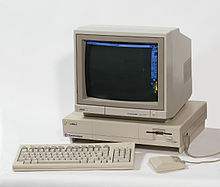
Back Amiga 1000 ALS Amiga 1000 BS Amiga 1000 German Amiga 1000 Spanish Amiga 1000 Basque آمیگا ۱۰۰۰ Persian Amiga 1000 Finnish Amiga 1000 French Amiga 1000 Croatian Amiga 1000 Hungarian
 Amiga 1000 with 1081 monitor | |
| Manufacturer | Commodore |
|---|---|
| Product family | Amiga |
| Type | Personal computer |
| Release date | July 23, 1985 |
| Introductory price | US$1,285 (1985) US$3,600 (2024 equivalent) |
| Discontinued | 1987 |
| Operating system | AmigaOS 1.0 |
| CPU | Motorola 68000 @ 7.16 MHz (NTSC) 7.09 MHz (PAL) |
| Memory | ROM 256 KB,[1] RAM 256 KB[2] (8.5 MB maximum) |
| Graphics | OCS 640×512i 6-bpp |
| Sound | Paula 4× 8-bit channels at max. 28 kHz in stereo |
| Dimensions | Width: 451 mm Height: 108 mm Depth: 330 mm[3] |
| Mass | 5.9 kg (13 lb) |
| Successor | Amiga 2000/2500, Amiga 500 |
The Amiga 1000, also known as the A1000, is the first personal computer released by Commodore International in the Amiga line. It combines the 16/32-bit Motorola 68000 CPU which was powerful by 1985 standards with one of the most advanced graphics and sound systems in its class. It runs a preemptive multitasking operating system that fits into 256 KB of read-only memory[1][4][5] and was shipped with 256 KB of RAM.[2] The primary memory can be expanded internally with a manufacturer-supplied 256 KB module for a total of 512 KB of RAM. Using the external slot the primary memory can be expanded up to 8.5 MB.[2]
- ^ a b "Inside the Amiga 1000 - Slideshow". Archived from the original on June 24, 2016. Retrieved May 14, 2016.
The WCS included 256KB of memory used specifically to hold a basic OS that had to be loaded from a floppy disk at boot time.
- ^ a b c "Inside the Amiga 1000 - Slideshow". Archived from the original on June 24, 2016. Retrieved May 14, 2016.
Commodore designed the Amiga to accept a user-installed 256KB RAM module, shown here, to raise the system memory to 512KB.
- ^ "Amiga 1000 Spec Sheet". www.obsoletecomputermuseum.org.
- ^ John C. Dvorak (October 22, 1996). "Inside Track". PC Magazine. p. 89.
The Amiga OS remains one of the great operating systems of the past 20 years, incorporating a small kernel and tremendous multitasking capability the likes of which have only recently been developed in OS/2 and Windows NT. The biggest difference is that the Amiga OS could operate fully and multitask in as little as 256K of address space. Even today, the OS is only about 1MB in size. And to this day, there is very little a memory-hogging, CD-ROM-loading OS can do the Amiga can't. Tight code—there's nothing like it.
I've had an Amiga for maybe a decade. It's the single most reliable piece of equipment I've ever owned. It's amazing! You can easily understand why so many fanatics are out there wondering why they are alone in their love of the thing. The Amiga continues to inspire a vibrant—albeit cultlike—community, not unlike that which you have with Linux, the Unix clone. - ^ 256 KB ROM + 256 KB RAM